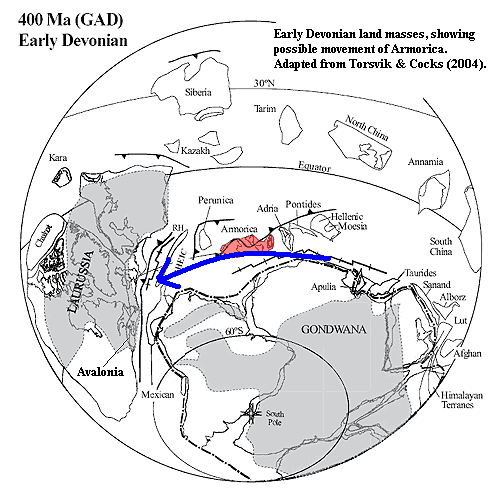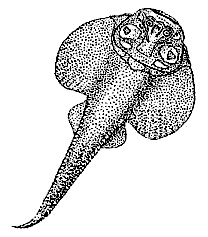Armorica
Terrane: Late Ordovician - Devonian
Armorica
 Today, Armorica is represented by (depending on exactly how it is defined) Brittany and parts of Spain, Italy, and perhaps even Poland. The belief for many years was that Avalonia and Armorica and were two microplates which detached from northern, or possibly eastern, Africa during the Silurian and drifted north across the Rheic Ocean to fuse with Laurentia Avalonia) and Baltica (Armorica) during the Devonian period.
Today, Armorica is represented by (depending on exactly how it is defined) Brittany and parts of Spain, Italy, and perhaps even Poland. The belief for many years was that Avalonia and Armorica and were two microplates which detached from northern, or possibly eastern, Africa during the Silurian and drifted north across the Rheic Ocean to fuse with Laurentia Avalonia) and Baltica (Armorica) during the Devonian period.
It now appears that the case is considerably more complex. First, Armorica may not be a single "microcontinent," but a series of even smaller structures which need not have traveled along the same trajectory or at the same time. Second, the train schedule has become much more confused. For example, Tychsen & Harper (2004) note a special biotic affinity between Armorica and Apulia (now part of southern Italy). However, as the map indicates, Torsvik & Cocks (2004) show Apulia still attached to North Africa in the Devonian, with Armorica contacting Baltica only in the Carboniferous.
Finally, the direction of travel, as displayed in some recent papers, has become almost due west, rather than directly northward. This counterclockwise rotation in paleogeographical thinking results from placing Euramerica or Laurussia or whatever) far southwest of its previously proposed position, and some odd gyrations by Africa. We're a little uncomfortable with the story because, among other things, it requires South America to move northward at a remarkable clip, while rotating counterclockwise. By way of example, this requires the region corresponding to Guyana to move from about 65° S. to almost 20° S. latitude in only 120 Mya. However, the resulting average speed (about 5cm/yr) is not really unreasonable for plate movements.
Perhaps the more peculiar phenomenon is the very slow movement of Armorica itself. According to some workers, Armorica is believed to have departed Africa as early as the beginning of the Cambrian. Meert & Lieberman (2004). It then traveled about the same distance (c. 5000 km) to reach Baltica, but dawdled along at half the pace of South America. Then again, it may be that Armorica had further to go. See the page on Avalonia for another model of this complex dance, requiring even more steps.
We are more comfortable with a Late Ordovician departure date for Armorica, with an arrival at Baltica in the Late Devonian.
Name: Armorica
Status: microcontinent
Duration: Silurian to
Devonian
Included the present-day Iberian peninsula, northwest France (Armorica region), southern Germany, Bohemia
Fragmented from: Gondwana
Collided with: Gondwana or
Euramerica
Early to Middle Devonian Armorican Flora and Fauna
References
Meert, JG & BS Lieberman (2004), A palaeomagnetic and palaeobiogeographical perspective on latest Neoproterozoic and early Cambrian tectonic events. J. Geol. Soc. 161: 477-487.
Torsvik, TH & LRM Cocks (2004), Earth geography from 400 to 250 Ma: a palaeomagnetic, faunal and facies review. J. Geol. Soc.161: 555-572.
Tychsen, A & DAT Harper (2004), Ordovician-Silurian distribution of Orthida (Paleozoic Brachiopoda) in the Greater Iapetus Ocean Region. Palaeo. Elec.7(1): 3.
ATW080313 (text), MAK02xxxx, edited RFVS111108
 Today, Armorica is represented by (depending on exactly how it is defined) Brittany and parts of Spain, Italy, and perhaps even Poland. The belief for many years was that Avalonia and Armorica and were two microplates which detached from northern, or possibly eastern, Africa during the Silurian and drifted north across the Rheic Ocean to fuse with Laurentia Avalonia) and Baltica (Armorica) during the Devonian period.
Today, Armorica is represented by (depending on exactly how it is defined) Brittany and parts of Spain, Italy, and perhaps even Poland. The belief for many years was that Avalonia and Armorica and were two microplates which detached from northern, or possibly eastern, Africa during the Silurian and drifted north across the Rheic Ocean to fuse with Laurentia Avalonia) and Baltica (Armorica) during the Devonian period.
